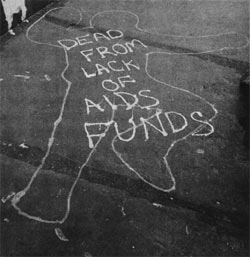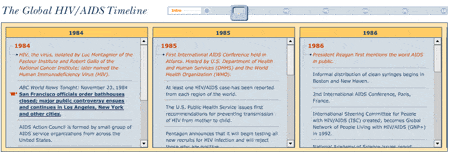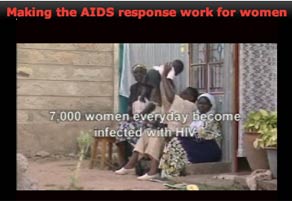by Mary Lou Greenberg
“Silence = Death.” The shout of AIDS activists cut like a knife through public ignorance, denial and official disregard of HIV/AIDS in the late ’80s.
Today, denial and ignorance are again taking a huge toll – but the oppression of women in society is twisting the HIV-AIDS epidemic in a newly horrific way.

In the ’80s, the words “women” and “AIDS” were rarely heard in the same sentence. When Merle Hoffman wrote about her visit in 1985 to Ward 86, the AIDS ward at San Francisco General, only 8 percent of the new diagnoses in the U.S. were of females. Today, that figure is 27 percent, a threefold increase. And in Sub-Saharan Africa with two-thirds of the world’s HIV-positive people, 62 percent of them are women and adolescent girls.
Today, the HIV/AIDS epidemic is becoming defined by its most rapidly-growing population – WOMEN. But “Silence = Death” has yet to be raised on behalf of them.
Cocktail of Oppressions
Why women?
In every country today, the devaluation of women and their subordinate economic and social status – whether enforced by patriarchal tradition, law, religion or a fist in the face – keep women from the ability to protect themselves and seek treatment. The obsolete view of women as men’s property whose sexuality must be controlled, combines with women’s poverty and profit-driven pharmaceuticals to create a deadly “cocktail” for the growing feminization of the HIV/AIDS epidemic.
In the 21st century, HIV/AIDS, a preventable and treatable disease, is the leading cause of death in the U.S. among young black women (ages 24-34). The women are in the prime of the lives, and most contracted the disease from husbands or boyfriends. An astonishing 80 percent of the women infected in the U.S. are women of color. Advanced antiretroviral drug therapy is failing to reach or help them: in the U.S., twenty percent more women die of AIDS after contracting an HIV infection than do men.
Gender, race, power, economic and medical inequities are all implicated
Back to Sex Stereotypes and Gender Imbalance
How did it come to this?
The still-prevalent belief that HIV/AIDS is the result of promiscuity or sexual “laxness” hits women especially hard. Women are judged more harshly for real or imagined sexual “transgressions.”
HIV transmission is an “issue of power in relationships,” says Dr. Susan Blumenthal, Senior Policy and Medical Advisor for amfAR (American Foundation for AIDS Research) who convened the first National Institutes of Health conference on women and AIDS in 1984. Women are in a disadvantaged position, she says, and it is more difficult for them to negotiate safer sex and insist that their male partners use condoms. In addition, women who are raped or preyed upon sexually at a young age are completely powerless.
Marriage, monogamy and religion-based traditional morality do not protect women from acquiring the virus. Globally, more than four-fifths of new HIV infections in women result from sex with a husband or primary partner. In Ghana, married women are almost three times more likely to be HIV-positive than women who have never been married. Foreign aid programs that emphasize marriage and abstinence-only and downplay condom use, are contributing to murder and genocide.
Less research and attention to the particularities of women’s lives and physiological makeup have been disastrous. Blumenthal emphasizes the need for “science-based strategies” in education about HIV/AIDS. Women need greater access to nonjudgmental healthcare.
Stigma associated with HIV/AIDS is particularly devastating for women. An amfAR study showed “pervasive negative views of HIV-positive women” and discomfort in associating with HIV-positive women. [LINK to Ginty.] HIV-positive women are so afraid of being judged negatively that they often hide their diagnosis from sexual partners, family and close friends. Worse, this sense of shame prevents women from getting tested. They may postpone until they have symptoms of full-blown AIDS, when treatment is more difficult.
The reason why stigma is especially damaging to women, says Blumenthal, comes to this: “socio-economic status, fewer resources and social inequities.”
New Breaking of New Silence
HIV/AIDS activism peaked in the ’80s and ’90s. With the development of effective treatment and a decrease in mortality, the urgency left, says Blumenthal. This led to complacency, a sense that the epidemic is under control.
In reality, there are 40,000 new infections in the U.S. each year; each day, 7,000 women around the world are infected with HIV.
The only thing that has changed now is that the deadly effect of “silence” has spread to women. Silence=Women’s Death.
We’ve got to break the silence, end the stigma and expose the reality of women’s vulnerability and the gender bias that places them at risk of HIV-AIDS. This is an urgent call to everyone who cares about women’s lives – men, as well as women, but especially women – to stand with our sisters hardest hit and refuse to accept the further devastation of this disease.
Mary Lou Greenberg has been an activist since the early days of the 1960’s women’s liberation movement and has defended abortion clinics across the country from anti-women fanatics. She has written for a number of publications, including the print edition of On the Issues Magazine.


